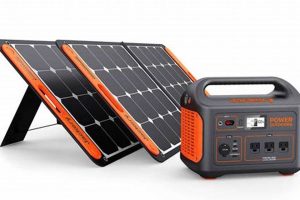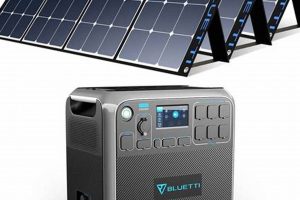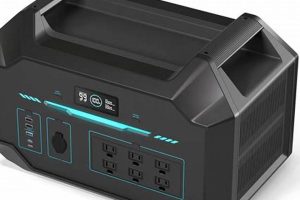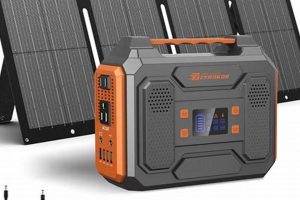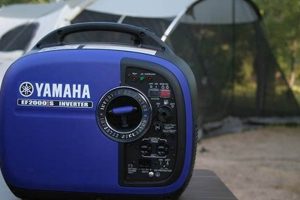A home-assembled system for generating electricity from sunlight offers off-grid power for various applications. Such systems typically include solar panels, a charge controller, a battery for energy storage, and an inverter to convert direct current (DC) electricity to alternating current (AC) for powering standard devices. An example would be a system constructed with readily available components, providing electricity for camping, emergency preparedness, or powering small appliances in areas with limited grid access.
Independent power generation offers significant advantages, including cost savings on electricity bills, reduced reliance on fossil fuels, and enhanced resilience during power outages. The increasing affordability of solar components and the growing awareness of environmental concerns have contributed to the rising popularity of these systems. Historically, self-reliance in energy production was a necessity in remote locations, but technological advancements have made it a viable and attractive option for a wider range of applications.
This exploration delves into the core components of such systems, including detailed information on panel selection, charge controller types, battery chemistries, and inverter specifications. Further topics include sizing a system to meet specific power demands, assembly instructions, and safety considerations.
Tips for Constructing a Portable Solar Power System
Careful planning and component selection are essential for building an effective and safe independent power source. The following tips offer guidance for a successful project.
Tip 1: Accurately assess power requirements. Calculate the total wattage needed to power the intended devices. This determines the necessary solar panel capacity and battery storage.
Tip 2: Choose appropriate solar panels. Consider panel type (monocrystalline, polycrystalline, or thin-film), wattage, and voltage based on energy needs and portability requirements.
Tip 3: Select a compatible charge controller. A charge controller regulates the flow of energy from the solar panels to the battery, preventing overcharging and damage. PWM and MPPT controllers offer different levels of efficiency.
Tip 4: Opt for a suitable battery. Deep-cycle batteries, such as AGM or lithium-ion, are designed for frequent charging and discharging. Battery capacity is measured in ampere-hours (Ah) and should align with the intended usage duration.
Tip 5: Choose the correct inverter. Inverters convert DC electricity from the battery to AC power. Select an inverter with sufficient wattage and the appropriate output voltage and frequency for the target devices.
Tip 6: Prioritize safety. Use appropriately sized wiring and fuses to prevent overheating and fire hazards. Ensure proper ventilation for batteries and electronic components. Consult local electrical codes and regulations.
Tip 7: Plan for portability. Choose a suitably sized enclosure to house the components and consider the weight and dimensions of the finished system for easy transport.
Adhering to these tips ensures a functional, safe, and portable power source tailored to specific energy needs. Careful planning and execution are vital for maximizing efficiency and longevity.
By following these guidelines, individuals can successfully build a system providing reliable off-grid power. The subsequent sections offer a more in-depth examination of specific components and assembly procedures.
1. Planning
Thorough planning forms the foundation of a successful portable solar generator project. A well-defined plan mitigates potential issues, optimizes performance, and ensures the finished system meets specific power requirements. This crucial initial stage encompasses several key considerations. Power needs dictate system sizing; a camping trip requiring only phone charging necessitates a smaller system compared to one powering a refrigerator. Usage patterns, including daily energy consumption and peak demand, influence battery capacity and solar panel wattage. Available sunlight in the intended location affects panel selection and orientation. Budget constraints play a critical role in component choices, balancing cost with performance. For example, a higher initial investment in more efficient panels might reduce the required number of panels, minimizing size and weight for increased portability. Ignoring these factors can lead to an underpowered system, an oversized and cumbersome build, or unexpected costs. A detailed plan encompassing these elements ensures a functional and efficient system tailored to specific needs.
Real-world applications demonstrate the practical significance of meticulous planning. A system designed for emergency home backup requires higher capacity and different features compared to one intended for camping. The former might prioritize a larger battery bank and an inverter capable of handling household appliances, while the latter benefits from portability and lighter components. Calculating daily energy consumption for essential devices during a power outage is crucial for determining battery capacity. Similarly, understanding the wattage requirements of devices used during camping trips guides solar panel selection. Failing to adequately plan for these scenarios can result in a system unable to meet the required demands, rendering it ineffective during critical situations. Accurate load calculations and device specifications are fundamental for a successful outcome.
In conclusion, planning is not merely a preliminary step but a critical determinant of a portable solar generator’s effectiveness. It bridges the gap between abstract concepts and practical implementation. Meticulous planning translates directly into a functional and efficient system, maximizing resource utilization and minimizing potential complications. The complexity of these systems necessitates careful consideration of interconnected factors, ensuring the final product aligns with the intended purpose. Addressing potential challenges proactively through careful planning ensures the system’s long-term viability and effectiveness.
2. Component Selection
Component selection is paramount in constructing a functional and efficient do-it-yourself portable solar power system. Each component plays a crucial role, and informed choices directly impact the system’s overall performance, longevity, and safety. An understanding of the interplay between these components is essential for a successful outcome. Selecting an inappropriately sized charge controller, for instance, can lead to battery damage from overcharging or limit the energy harvested from the solar panels. Similarly, an underpowered inverter may fail to operate certain devices, rendering the system ineffective for its intended purpose. Harmonizing the specifications of each component ensures optimal power generation, storage, and utilization.
Real-world examples illustrate the practical significance of informed component selection. Consider a scenario requiring a system to power a laptop and a small refrigerator during camping trips. Selecting high-efficiency monocrystalline solar panels maximizes energy generation in limited space, while a deep-cycle lithium-ion battery provides ample storage for overnight power. A pure sine wave inverter safeguards sensitive electronics like laptops from damage. Conversely, opting for less efficient panels or a smaller battery may result in insufficient power, while a modified sine wave inverter could harm sensitive electronic equipment. Careful consideration of load requirements and environmental conditions informs these choices, ensuring the system meets specific needs.
In summary, effective component selection hinges on understanding individual component functions and their interdependence within the system. This understanding translates directly into a tailored power solution optimized for its intended application. Careful consideration of energy demands, environmental factors, and budgetary constraints allows builders to make informed decisions, maximizing the system’s efficiency and longevity. Negligence in component selection can lead to system failure, safety hazards, and ultimately, an ineffective solution. Therefore, informed component selection is not merely a step in the construction process but a critical determinant of a successful and sustainable portable solar power system.
3. Assembly
The assembly process is a critical stage in realizing a functional and safe do-it-yourself portable solar power system. Proper assembly ensures the seamless integration of individual components, impacting overall system performance, safety, and longevity. Methodical execution based on a clear understanding of wiring diagrams and component functionalities is essential. Incorrect wiring can lead to system malfunction, battery damage, or even fire hazards. Conversely, precise assembly optimizes energy flow, maximizing power generation and utilization. This stage requires meticulous attention to detail and adherence to established safety practices.
Practical examples underscore the importance of correct assembly. Consider connecting solar panels in series versus parallel. Series connections increase voltage, while parallel connections increase current. Choosing the appropriate configuration depends on the charge controller and inverter specifications. Incorrect wiring can damage the charge controller or lead to inefficient charging. Similarly, improper battery terminal connections can result in corrosion, reduced battery lifespan, and safety risks. Furthermore, inadequate ventilation during assembly can cause overheating, impacting component longevity and potentially creating fire hazards. Therefore, understanding the nuances of each connection and following recommended practices is crucial.
In conclusion, assembly is not merely a construction step but a defining factor in a portable solar generator’s success. Meticulous attention to detail and adherence to safety standards are paramount. A thorough understanding of component functionalities and their interconnections ensures a functional and safe system. Errors during assembly can compromise system performance, create safety hazards, and ultimately negate the benefits of a self-built system. Therefore, proper assembly, guided by accurate information and careful execution, is crucial for realizing the full potential of a do-it-yourself portable solar power system.
4. Safety
Safety is paramount when designing, assembling, and operating a self-built portable solar power system. Overlooking safety considerations can lead to significant hazards, including fire, electric shock, and equipment damage. Understanding potential risks and implementing appropriate precautions is essential for ensuring user well-being and system longevity. This section explores critical safety aspects related to these systems.
- Electrical Hazards
Working with electricity always presents inherent risks. Incorrect wiring, inadequate insulation, and improper grounding can lead to electric shock or fire. Using appropriately sized wiring, fuses, and circuit breakers is crucial. For example, using undersized wiring can cause overheating and potentially ignite flammable materials. Employing a ground fault circuit interrupter (GFCI) adds an extra layer of protection against shock. Regularly inspecting wiring and connections for damage is essential for preventing electrical hazards. Adhering to established electrical codes and standards minimizes risks.
- Battery Safety
Batteries, particularly lead-acid batteries, contain hazardous chemicals and generate explosive gases during charging. Proper ventilation is essential to prevent gas buildup. Avoiding sparks or open flames near batteries is crucial. Using appropriate personal protective equipment (PPE), such as gloves and eye protection, during battery handling minimizes chemical exposure risks. Overcharging or short-circuiting batteries can cause thermal runaway, leading to fire or explosion. Employing a properly configured charge controller mitigates these risks. Selecting the correct battery type for the intended application also contributes to overall safety. For instance, lithium-ion batteries offer inherent safety advantages over lead-acid batteries in certain applications.
- Fire Hazards
Flammable materials, combined with electrical components and potential sources of ignition, create a fire risk. Maintaining proper clearance between components and flammable materials is crucial. Ensuring adequate ventilation prevents heat buildup, which can ignite surrounding materials. Using fire-resistant enclosures and wiring further reduces risks. Regularly inspecting the system for signs of overheating or damage is essential for fire prevention. Having a fire extinguisher readily available near the system adds an extra layer of safety.
- Environmental Considerations
Improper disposal of batteries and solar panels poses environmental hazards. Recycling these components through appropriate channels minimizes environmental impact. Solar panels contain materials that require specialized recycling processes. Disposing of lead-acid batteries in landfills can contaminate soil and groundwater. Adhering to local regulations for battery and solar panel disposal ensures environmentally responsible practices.
These safety considerations are integral to the design, assembly, and operation of any portable solar generator. Ignoring these aspects can compromise not only the system’s functionality but also the safety of users and the surrounding environment. Implementing these precautions ensures a safe and sustainable power solution.
5. Portability
Portability is a defining characteristic of these self-assembled power systems, directly influencing design choices and component selection. The intended use cases dictate the level of portability required, ranging from compact systems for backpacking to larger units for vehicle-based camping or emergency power. Balancing weight, size, and power output is crucial for optimizing portability without compromising functionality. This section explores key facets of portability in the context of building these systems.
- Size and Weight
The physical dimensions and weight of a system determine its ease of transport. Smaller, lighter components, such as foldable solar panels and compact lithium-ion batteries, enhance portability. However, these choices often come at a premium cost. Larger, heavier components, like lead-acid batteries and rigid solar panels, increase power output but reduce portability. Balancing these trade-offs is crucial for aligning the system with specific needs. A system designed for backpacking necessitates minimizing size and weight, potentially sacrificing some power capacity. Conversely, a system intended for car camping can accommodate larger components for increased power output.
- Enclosure Design
The enclosure protects the components and provides a means for transporting the system. Durable, weather-resistant enclosures safeguard against environmental factors. Integrated handles, wheels, and carrying straps enhance portability. The enclosure’s design also impacts usability. Well-organized enclosures with clearly labeled connections simplify setup and operation. Ergonomic design considerations, such as the placement of handles and the weight distribution within the enclosure, contribute to comfortable transport.
- Modular Design
A modular design allows for flexibility and adaptability. Components that can be easily disconnected and reconnected facilitate transport and storage. This approach allows for customization based on specific power needs. For example, a modular system could allow for adding or removing solar panels or batteries depending on the application. This adaptability enhances the system’s versatility and long-term usability. Modular designs also simplify maintenance and repair, as individual components can be easily replaced.
- Integrated Features
Integrated features, such as built-in charge controllers, inverters, and displays, streamline system functionality and reduce overall size. Combining multiple functions within a single unit enhances portability. For instance, an all-in-one unit with a built-in charge controller, inverter, and battery management system simplifies the assembly process and reduces the overall system footprint. These integrated features also contribute to a cleaner and more organized setup.
These facets of portability highlight the interconnectedness between design choices and practical application. Balancing size, weight, functionality, and cost considerations is crucial for building a system that meets specific portability requirements without compromising performance or safety. A well-designed portable solar power system offers convenient access to renewable energy wherever it is needed.
6. Cost-Effectiveness
Cost-effectiveness represents a significant driver in the adoption of self-assembled portable solar power systems. Building such a system offers potential cost savings compared to purchasing a pre-built unit, particularly for individuals with specific power requirements or budgetary constraints. However, achieving cost-effectiveness requires careful planning, component selection, and assembly. Balancing initial investment against long-term operational costs is essential. Opting for lower-cost components might reduce upfront expenses but could lead to higher maintenance costs or reduced lifespan, ultimately diminishing overall cost-effectiveness. Conversely, investing in higher-quality, more efficient components might increase initial costs but potentially result in lower long-term expenses due to increased durability and performance. Real-world examples illustrate this balance; choosing a less expensive lead-acid battery over a lithium-ion battery might offer initial savings but require more frequent replacement, negating the initial cost advantage over time. Similarly, opting for lower-wattage solar panels might seem cost-effective initially but necessitate a larger array to achieve the desired power output, potentially increasing overall system cost and complexity.
Further analysis reveals that cost-effectiveness extends beyond component pricing. Factors such as system lifespan, maintenance requirements, and potential repair costs contribute to the overall cost equation. A well-designed and properly assembled system, even with a higher initial investment, can offer significant long-term cost savings due to reduced maintenance and increased longevity. Conversely, a poorly designed or hastily assembled system might require frequent repairs or component replacements, diminishing its cost-effectiveness over time. Practical applications demonstrate this principle. A system built with high-quality, weather-resistant components and meticulous attention to wiring and connections requires less maintenance and replacement, reducing long-term costs compared to a system built with lower-quality components and inadequate assembly practices. Furthermore, incorporating energy-efficient appliances and usage patterns maximizes the system’s cost-effectiveness by minimizing energy consumption and extending battery life.
In summary, cost-effectiveness in constructing a portable solar power system hinges on a comprehensive evaluation of factors beyond initial component costs. System lifespan, maintenance requirements, and potential repair costs play crucial roles in determining overall value. While initial cost savings can be attractive, prioritizing quality components and meticulous assembly often leads to greater long-term cost-effectiveness. Understanding this interplay of factors allows individuals to make informed decisions, balancing initial investment against long-term operational costs and maximizing the return on investment for their self-built power solution. This approach ensures a sustainable and economically viable solution for off-grid power needs.
Frequently Asked Questions
This section addresses common inquiries regarding the construction and utilization of personally assembled portable solar power systems. Clear and concise answers provide practical guidance for individuals exploring this approach to off-grid power generation.
Question 1: What are the typical costs associated with building a portable solar power system?
Costs vary significantly depending on desired capacity, component quality, and system complexity. A basic system might range from a few hundred to over a thousand dollars. Higher capacity and premium components increase costs. Thorough research and price comparisons are recommended.
Question 2: How much power can a portable solar generator realistically produce?
Power output depends on solar panel wattage and sunlight availability. A typical portable system might generate several hundred watts, sufficient for charging smaller devices or powering essential appliances. Larger systems can power more demanding equipment.
Question 3: What type of battery is best suited for a portable solar generator?
Deep-cycle batteries, such as lithium-ion or AGM, are recommended due to their ability to withstand repeated charging and discharging cycles. Lithium-ion batteries offer higher energy density and longer lifespans but come at a premium cost. AGM batteries provide a balance of performance and affordability.
Question 4: How long does it take to charge a portable solar generator?
Charging time depends on solar panel wattage, battery capacity, and sunlight intensity. A typical system might require several hours of direct sunlight to fully charge. Using higher-wattage panels reduces charging time.
Question 5: What safety precautions are essential when building a portable solar generator?
Working with electricity and batteries necessitates careful attention to safety. Using appropriate wiring, fuses, and circuit breakers is crucial. Proper ventilation for batteries prevents gas buildup. Adhering to established electrical codes and standards minimizes risks.
Question 6: What maintenance is required for a portable solar generator?
Regular inspection of wiring, connections, and battery health is recommended. Cleaning solar panels maximizes energy capture. Proper storage practices, particularly for batteries, extend lifespan. Specific maintenance requirements vary based on component selection.
Understanding these fundamental aspects empowers individuals to make informed decisions about constructing and utilizing a self-assembled portable solar power system. Careful planning, component selection, and adherence to safety guidelines contribute to a successful and sustainable off-grid power solution.
This concludes the frequently asked questions section. The following sections will offer a deeper dive into specific component selection and system design considerations.
Conclusion
Constructing a personalized, transportable solar power system presents a viable pathway to energy independence and resilience. Careful consideration of component selection, system design, and safety practices are essential for achieving a functional and efficient outcome. This exploration has highlighted the importance of accurate power requirement assessments, appropriate component choices, and meticulous assembly procedures. The interplay between solar panels, charge controllers, batteries, and inverters determines overall system performance and longevity. Adherence to safety guidelines mitigates potential hazards associated with electrical systems and battery handling. Portability considerations, including size, weight, and enclosure design, influence system practicality and usability. Finally, a thorough cost-benefit analysis ensures that the chosen components and design align with budgetary constraints while maximizing long-term value.
The growing accessibility of components and the increasing awareness of sustainable energy solutions position these systems as a compelling alternative to traditional power sources. Empowering individuals with the knowledge and resources to construct these systems fosters self-reliance and promotes a transition towards cleaner energy practices. Continued advancements in solar technology and battery storage promise even greater efficiency and affordability in the future, further solidifying the role of personalized power generation in meeting evolving energy needs. The potential for broader adoption underscores the significance of understanding and implementing best practices in design, assembly, and safe operation of these transformative systems.

